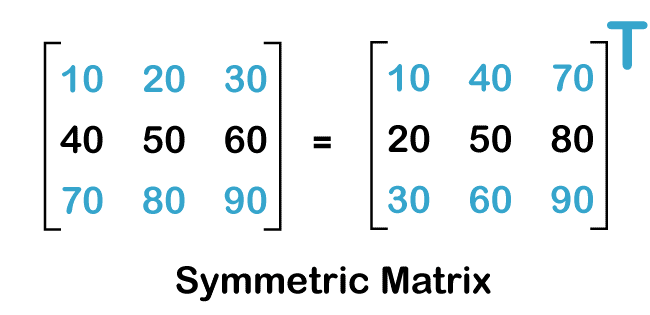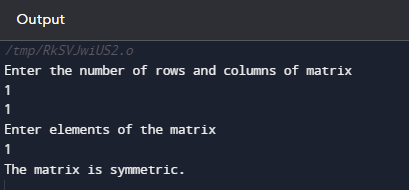Symmetric Matrix in C
In technical terms, a symmetric matrix is defined as an n x n matrix A where the element at the ith row and jth column (A_ij) is equal to the element at the jth row and ith column (A_ji) of A for all values of i and j. This makes it so that data can be read from top to bottom as well as from left to right.
A symmetric matrix can be defined in such a way that a square matrix is equal to its transpose. For example, if we take a square matrix A = aijaijaij, it is said to be symmetric only if aij= aji for all values of i and j, that is, if a12 = a21, a23 = a32, etc. If A is a symmetric matrix then A’ = A where A’ is a transpose matrix of A.
We can take the example of the given figure:

The program code is given below:
#include<stdio.h>
int main()
{
int m, n, c, d, matrix[10][10], transpose[10][10];
printf("Enter the number of rows and columns of matrix\n");
scanf("%d%d", &m, &n);
printf("Enter elements of the matrix\n");
for (c = 0; c < m; c++)
for (d = 0; d < n; d++)
scanf("%d", &matrix[c][d]);
for (c = 0; c < m; c++)
for (d = 0; d < n; d++)
transpose[d][c] = matrix[c][d];
if (m == n) /* check if order is same */
{
for (c = 0; c < m; c++)
{
for (d = 0; d < m; d++)
{
if (matrix[c][d] != transpose[c][d])
break;
}
if (d != m)
break;
}
if (c == m)
printf("The matrix is symmetric.\n");
else
printf("The matrix isn't symmetric.\n");
}
else
printf("The matrix isn't symmetric.\n");
return 0;
}
Properties of Symmetric Matrix
Some properties of symmetric matrices in C include:
1. A symmetric matrix is always square.
2. The main diagonal of a symmetric matrix is also always symmetric.
3. If A and B are symmetric matrices of the same size, then A + B and A - B are also symmetric matrices.
4. If A is a symmetric matrix and k is scalar, then kA will also be referred to as a symmetric matrix.
5. The product of two symmetric matrices is not always said to be a symmetric matrix.
6. The transpose of a symmetric matrix is always equal to itself.
7. In order to check if a matrix is symmetric in C, one can write a function that loops through the elements of the matrix and checks if A[i][j] is equal to A[j][i] for all i and j such that 0 <= i, j < n.
8. The addition or subtraction of any two symmetric matrices will always be considered to as symmetric in nature.
Inverse of a Symmetric Matrix
A symmetric matrix is a square matrix in which the elements are symmetric about the main diagonal. The inverse of a symmetric matrix A is only defined if the determinant of A is a non-zero.
If A is a symmetric matrix, then the inverse of A is also to be known as a symmetric matrix. The formula to compute the inverse of a symmetric matrix A is given by:
A^-1 = (1/det(A)) * adj(A)
Where det(A) is the determinant of the matrix A, and adj(A) is the adjugate or classical adjoint of A. The adjugate of A is the transpose of the cofactor matrix of A.
Importance of Symmetric Matrices in C Programming
When it comes to numerical programming, symmetric matrices are incredibly important. A symmetric matrix is a matrix that is equal to its transpose. Using symmetric matrices in C programming allows to easily take advantages of the full power of the machine.
By utilizing such matrices, we can reduce the number of computations needed significantly. This means that more work is done in less time and with less effort.
Additionally, if a program includes calculations involving matrix multiplication or inversion, symmetric matrices can lead to improved performance and accuracy.
Furthermore, there is also the benefit of saving disk space due to the fact that a symmetric matrix has only one set of coefficients instead of two sets for a general matrix.
Finally, when working with input data that must be stored and calculated multiple times over the course of a program's execution, it makes sense to store this information as a symmetric matrix in order to improve performance even further by avoiding redundant calculations.
How to Calculate a Symmetric Matrix
We can easily calculate/Solve a symmetric matrix using the following steps.
Step 1: Determine the Size
Firstly, we determine the size of the matrix. The simplest symmetric matrices will only have 2x2 dimensions, but we can also create matrices with 3x3 or higher dimensions if needed. Once we have determined size, we can start building the matrix.
Step 2: Add Values to Your Matrix
Now that know the size of the matrix, add values to it. Keep in mind that symmetric matrices must have elements in all positions that are symmetrical about their main diagonal. This means that for any number i and j (where i does not equal j), M[i][j] should equal M[j][i]. When adding values to matrix, make sure this is taken care of so that matrix remains symmetrical in all positions.
Step 3: Calculate the Square Root of the Determinant
After adding all the required values to the matrix, now calculate the square root of its determinant (the sum of all possible products of distinct combinations of numbers taken from different rows and columns). This number will be needed while checking if the matrix is indeed a Symmetric Matrix or not.
How to Use a Symmetric Matrix in C Programming
Using a symmetric matrix in C programming is actually pretty easy. It's all about understanding the basics of matrices and how they can be used to calculate different kinds of values. Here are the steps need to take:
Step 1: Declare the Matrix
The first thing we need to do is declare the matrix. This involves specifying the size of the matrix, as well as the elements that will be stored in it. This can be done with a two-dimensional array or a single-dimensional array, depending on what type of data an individual is working with.
Step 2: Calculate the Values
Next, the need to calculate values for each element in the matrix. For example, if we are working with two-dimensional arrays, then we need to use some form of multiplication or division depending on what kind of calculation we are trying to do. If we are using a single-dimensional array, then it's possible to use something like recursion or iteration to go through each row and column and add or subtract the elements.
Step 3: Use Symmetric Properties
Finally, once the values have been calculated, we can make sure that the matrix has symmetric properties - i.e., its elements are equal when their indices are switched around - by comparing each element with its opposite index counterpart (e.g., row 3 column 4 and column 4 row 3). If any mismatch is observed, then it will be known that the matrix has an error in it and needs to be corrected before proceeding further.
Common Problems and Solutions When Using Symmetric Matrices in C
While using a symmetric matrix in C, if one wants to make sure that it is done correctly or not? Here are some common problems and solutions that might come across when working with these matrices.
1. Memory Issues
When working with a symmetric matrix in C, one of the most common issues is memory allocation. Because most modern computers have algorithms that work with rectangular matrices, it can be difficult to allocate memory for the ‘half-filled’ portions of a symmetric matrix. The solution for this is to either switch your data structure or use available library functions which handle the allocation of memory differently than the standard system calls.
2. Ordering Problems
Another common problem is ordering: Many problems need to be solved at specific points in a matrix before they can be solved at other points—but if the order is wrong, those points won't be solved, resulting in an incorrect result. To avoid this problem, we can use an algorithm specifically designed for this purpose (e.g., an algorithm that orders the rows and columns of a matrix). This will ensure that the correct order is maintained throughout the process, so we can get accurate results every time.
3. Cache Locality Issues
Finally, there are cache locality issues to consider when using a symmetric matrix in C. If the data isn't stored properly or if there are too many cache misses (the computer tries to find data but can't), then the program may run slower than expected. The code can be optimized by using loop unrolling (which reduces branch mispredictions) and cache prefetching (which reduces cache misses). This will help to ensure that the program runs as quickly as possible.
Conclusion
With Symmetric Matrices, we have a powerful tool to help organize and analyze data. By understanding how to calculate and use these matrices, we can quickly and efficiently take advantage of the power of C language programming. As long as we understand how to use the matrix properly, we can make reliable decisions based on the data provided. Taking the time to learn the mathematical foundation behind Symmetric Matrices will help us to get the most out of C language programming, and will ultimately make the work more efficient.